Increase Your VO2 Max: Tips for Everyone
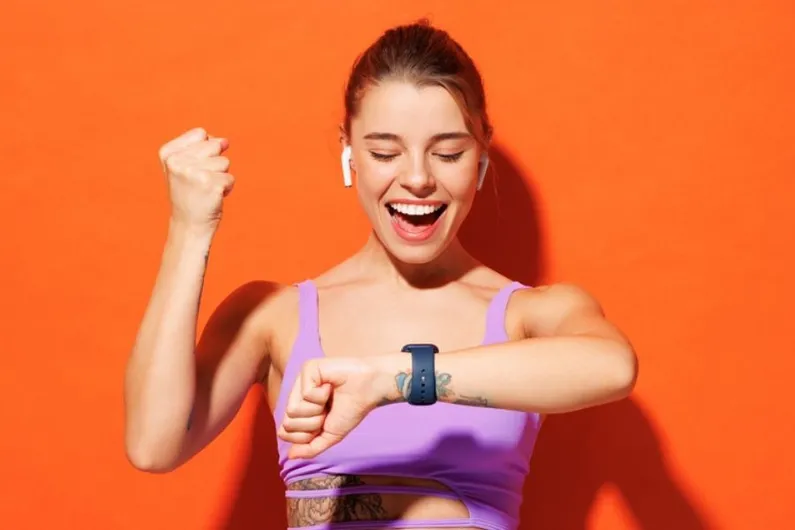
Increase Your VO2 Max: Tips for Everyone
Want to improve your stamina, endurance, and overall health? Boosting your VO2 max is the key. But what exactly is VO2 max? As we discussed in our previous post, “Understanding VO2 Max: Key to Healthy Aging,” it’s a measure of your body’s ability to transport and utilize oxygen during exercise. The good news is, that regardless of your age or fitness level, you can increase your VO2 max. Let’s explore some practical strategies for reaching your health and fitness goals and discuss ways MindStream can help.
What is VO2 Max?
VO2 Max is a measure of your body’s maximum ability to transport and utilize oxygen during exercise. In simpler terms, it’s a gauge of your aerobic fitness. A higher VO2 Max means better endurance, stamina, and cardiovascular health, not to mention overall health. We dive much deeper into what VO2 Max is and how it works in our “Understanding VO2 Max” post if you’d like to learn more about that.
Why is it important?
Improving your VO2 Max offers numerous benefits. Importantly, studies have shown that a higher score is a strong predictor of a longer life span. Some additional advantages include:
- Increased endurance and stamina
- Lower risk of heart disease
- Better weight management
- Improved mood and cognitive function
- Improved athletic performance
- Better overall health
How can I measure my VO2 Max?
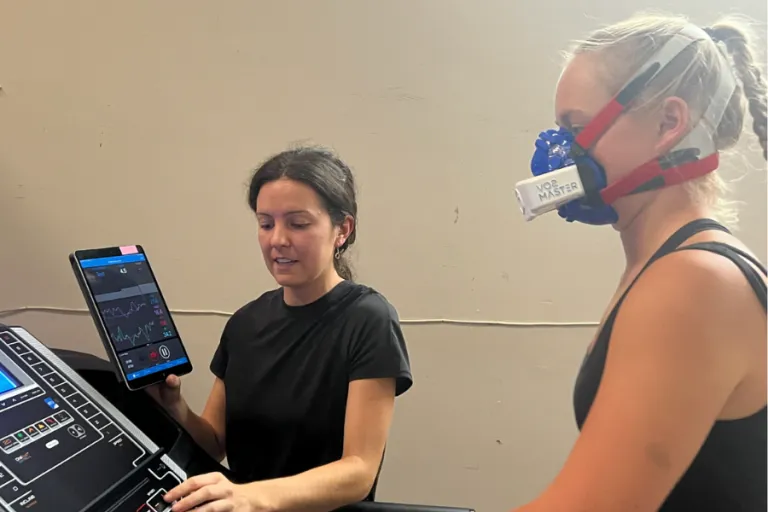
Measuring VO2 max accurately requires specialized equipment and often involves a laboratory setting. This is the most precise method and is typically used in research or clinical settings. Our facility at MindStream is equipped with this specialized equipment that enables us to test and evaluate your VO2 Max precisely.
There are also some less accurate but still informative ways to estimate your VO2 max. For example, many smartwatches and fitness trackers offer estimated VO2 max values based on your heart rate data. Though the data is not as reliable as lab testing, they can provide a general estimate and trends over time.
What is a ‘good’ VO2 Max?
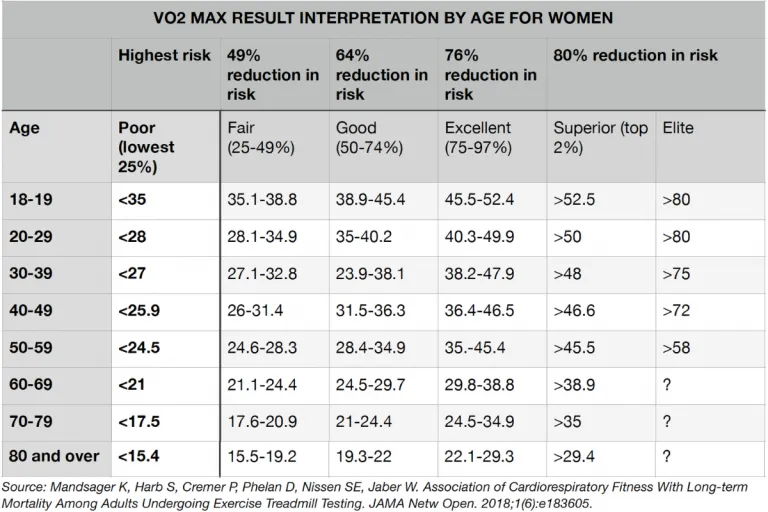
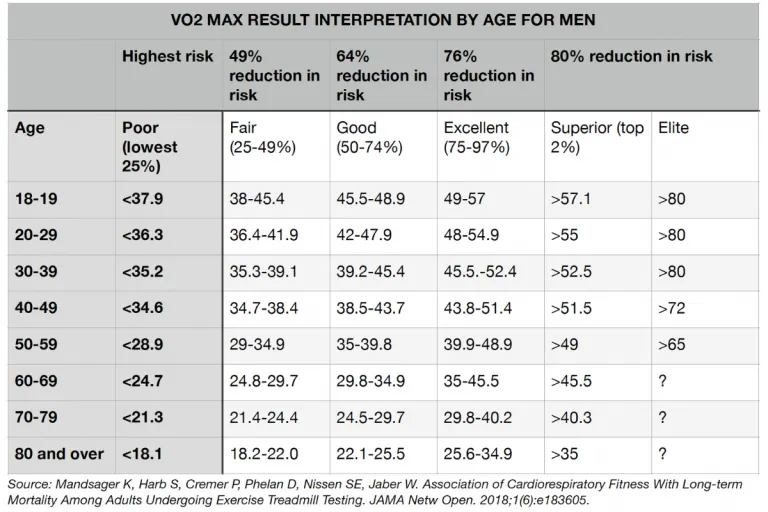
Determining a “healthy” VO2 max depends on several factors, primarily age, gender, and fitness level. There is no one-size-fits-all answer but for most adults, a VO2 max above the average for your age and gender is considered “good”. At MindStream, we use the tables below to help our patients understand how their fitness compares to people of the same age and gender. Although this provides a general reference point, we believe it’s essential to focus on personal improvement rather than continuing to compare yourself to others.
What should I do if I have a low VO2?
Don’t panic. Although a low VO2 can feel discouraging, improving it is possible. There are powerful approaches that can improve VO2 by up to 30% in just 8 weeks. While that’s impressive and requires a high level of dedication, we believe that the best efforts are implemented in ways that are sustainable, enjoyable, and personally relevant. These factors will help to ensure you succeed.
How can I increase my VO2 Max?
Consult with a healthcare provider to create a personalized plan.

First, remember that everyone is different. Factors like age, gender, genetics, fitness level, and underlying health conditions should all be considered when determining strategies to boost your VO2. Therefore, we highly recommend consulting with a healthcare provider before you begin.
Additionally, several types of workouts increase VO2. At MindStream, we work with you to set individualized goals and develop a plan to improve your cardiometabolic fitness and VO2 in a way that works for you personally. We understand that everyone has different needs when it comes to workout types, and no door is closed when it comes to ways to improve.
Example: Some genes affect a person’s tolerance of High-Intensity Interval Training (HIIT) workouts, where tolerance for HIIT is low and the required recovery is long. If you’re someone who’s struggled to work out or “do cardio,” getting insight from a genetic perspective may feel really empowering.
Follow these general exercise strategies to increase VO2 Max.
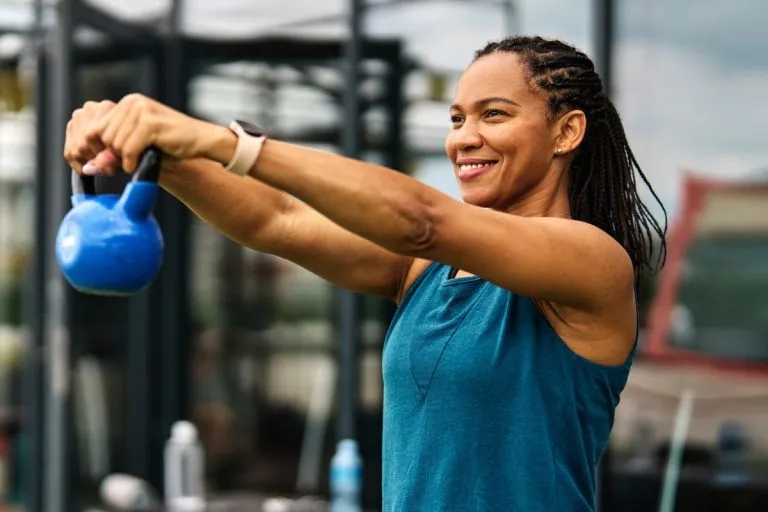
While the fundamental principles for improving VO2 Max remain consistent, the specific approach may vary based on individual needs and limitations. So, one or more of the following strategies may not work for you, and that’s okay.
High-Intensity Interval Training (HIIT)
- Short bursts of intense exercise followed by brief recovery periods. This challenges your cardiovascular system and boosts oxygen consumption.
- The purpose of these intervals is to approach or reach your maximum heart rate, a value that can be identified by completing a VO2 Max test.
- Example: 30 seconds of sprinting followed by 30 seconds of jogging, repeated multiple times.
Endurance Training
- Sustained exercise at a moderate pace helps build endurance and strengthens the heart.
- Example: 30-minute steady-state runs, swims, or bike rides.
Strength Training
- Increases muscle mass, improving oxygen utilization and metabolic efficiency.
- Example: Squats, lunges, push-ups, weightlifting exercises.
Cross-Training
- Incorporates different exercise types to prevent plateaus and challenge your body
- Example: Combine running, swimming, and cycling.
Remember: Progress, not perfection, is key. Celebrate small victories along the way, and don’t get discouraged if you don’t see immediate results.
What if my ability to exercise intensely is limited?
If you are unable to exercise intensely – for example, you are an older adult or have an underlying health condition – improving your VO2 max requires a cautious and personalized approach. While it’s possible to enhance your cardiovascular fitness, prioritizing safety and working within your limitations is paramount. Therefore, you should first consult with a healthcare provider who can help you determine the right approach for you. They may recommend focusing on strategies like:
Prioritize Low-Impact Activities
- Walking: Even brisk walking can improve cardiovascular health.
- Swimming: Low-impact and beneficial for overall fitness.
- Cycling: Adjust the intensity to match your abilities.
Build Endurance Gradually
- Start slow: Begin with short durations and gradually increase time.
- Consistency: Regular exercise, even at a lower intensity, is beneficial.
- Listen to your body: Pay attention to signals and avoid overexertion.
Incorporate Strength Training
- Focus on resistance bands or light weights: These can be easier on the joints.
- Consider working with a trainer: They can provide more specific guidance about weightlifting.
Improve Balance and Flexibility
- Improve stability: Reduces fall risk and enhances overall fitness.
- Yoga or tai chi: Offer balance, flexibility, and relaxation benefits.
Focus on Breathing Exercises
- Deep breathing: Improves lung capacity and oxygen intake.
- Diaphragmatic breathing: Helps strengthen respiratory muscles.
Maintain a Healthy Lifestyle
- Nutrition: A balanced diet provides energy for exercise.
- Hydration: Stay hydrated to support overall health.
- Sleep: Adequate rest aids in recovery and overall well-being.
- Stress: Meditation, yoga, or deep breathing can help.
Remember: Even small improvements can make a significant difference. Be patient with yourself and celebrate your achievements.
Important Considerations
Improving your VO2 max requires a comprehensive approach. Here are key factors to keep in mind:
Training Factors
- Consistency: Regular exercise is crucial for adaptation.
- Intensity: Incorporate both steady-state and high-intensity workouts if you’re able.
- Variety: Avoid plateaus by changing up your routine.
- Progression: Gradually increase the challenge of your workouts.
Recovery and Lifestyle
- Rest: Adequate sleep is essential for muscle repair and adaptation.
- Nutrition: Fuel your body with a balanced diet for optimal performance.
- Hydration: Stay hydrated to support oxygen transport.
- Stress management: Chronic stress can negatively impact performance.
Health Considerations
- Consult a doctor: Especially important if you have underlying health conditions.
- Listen to your body: Pay attention to signs of overtraining or injury.
- Gradual progression: Avoid pushing yourself too hard too soon.
Remember: Improving your VO2 max is a gradual process. Be patient, be consistent, and enjoy the journey towards better cardiovascular health.
In Conclusion
Remember, consistency is key when it comes to increasing your VO2 Max. Start with small steps and gradually increase your challenge. With dedication and the right guidance, you can achieve your fitness goals and enjoy the many benefits of a higher VO2 Max.
Learn more: Check out our post, “Understanding VO2 Max: Key to Healthy Aging” for more on what VO2 Max is and how it works.
MindStream Integrative Medicine Can Help.
We can support cardiometabolic programs in a variety of ways. Some clients want a little direction and a chance to circle back, while others prefer more interaction and accountability. We can work with your needs and preferences to help you accomplish your goals.
Why choose MindStream? We are an integrative medicine practice, offering a comprehensive approach to wellness that includes expert testing/analysis (like VO2 max testing), as well as personalized health coaching, exercise plans, nutrition counseling, movement practices (personal training, yoga, Pilates, etc.), weight training, stress management techniques, and much more. Our experts can help you develop a tailored program to improve your VO2 Max, metabolic health, and overall wellness.
Are you ready to boost your VO2 Max? Schedule a consultation with our team by calling 615.541.9933 or book online.
Disclaimer: This blog post is for informational purposes only and should not be construed as medical advice. Please consult with your healthcare provider before making any changes to your diet, exercise routine, or medication use.


